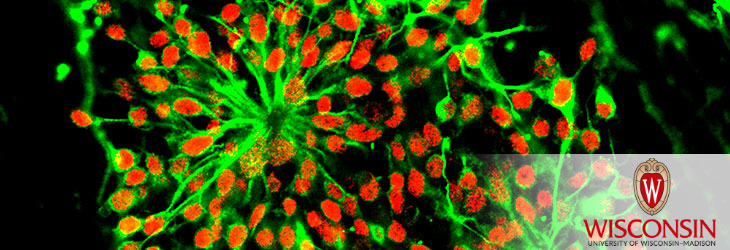Pluripotent Stem Cells

Hydrogel Arrays for Screening Cell-Substrate Interactions, Now in Multiwell Format
WARF: P140305US01
Inventors: William Murphy, Ngoc Nhi T. Le
The Wisconsin Alumni Research Foundation (WARF) is seeking commercial partners interested in developing a method to prepare hydrogel arrays having isolated and independently controlled spots.
Overview
While extensive research has been devoted to understanding the influence of medium conditions on cell development, researchers have only recently begun to understand the role of culture surface properties. Self-assembled monolayer (SAM) substrates are a valuable tool in this process, enabling researchers to systematically expose cells to various surface-bound molecules — such as proteins, nucleic acids and polysaccharides — and analyze how these molecules influence cell behavior.
However, SAM technology has yet to become commonplace for cell biologists because preparing arrays is labor intensive (a typical experiment may require close to 1,000 handling steps). To simplify the process, UW–Madison researchers recently developed a method for controlling the physical dimensions and chemical composition of individual spots in a hydrogel array (see WARF reference number P140097US01).
However, SAM technology has yet to become commonplace for cell biologists because preparing arrays is labor intensive (a typical experiment may require close to 1,000 handling steps). To simplify the process, UW–Madison researchers recently developed a method for controlling the physical dimensions and chemical composition of individual spots in a hydrogel array (see WARF reference number P140097US01).
The Invention
Building on their previous work, the researchers have now adapted their method to any commercially available, glass or polystyrene-bottom multiwell plate. In the new process, hydrogel is covalently immobilized to the bottom of each well and then selectively polymerized. In this way the spots are completely isolatable, allowing for systemic and independent control of their chemical composition and XYZ physical dimensions.
Once the hydrogel array is formed, each of the spots can be exposed to different soluble factors without risk of diffusion.
Once the hydrogel array is formed, each of the spots can be exposed to different soluble factors without risk of diffusion.
Applications
- Research tool for 2-D and 3-D assays, cell culture and drug discovery
Key Benefits
- Permits independent control over the size, shape and chemical composition of each spot in the array
- No barriers or other modifications required to prevent spillover
- Adaptable to any suitable multiwell format
- Compatible with a wide range of cell and ligand types
- Easier to make and use
- Supports enhanced throughput
Additional Information
For More Information About the Inventors
Related Technologies
For current licensing status, please contact Rafael Diaz at [javascript protected email address] or 608-960-9847